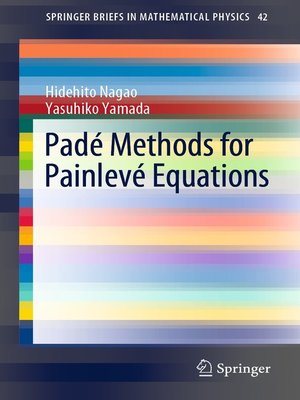Padé Methods for Painlevé Equations
ebook ∣ SpringerBriefs in Mathematical Physics
By Hidehito Nagao

Sign up to save your library
With an OverDrive account, you can save your favorite libraries for at-a-glance information about availability. Find out more about OverDrive accounts.
Find this title in Libby, the library reading app by OverDrive.



Search for a digital library with this title
Title found at these libraries:
| Library Name | Distance |
|---|---|
| Loading... |
The isomonodromic deformation equations such as the Painlevé and Garnier systems are an important class of nonlinear differential equations in mathematics and mathematical physics. For discrete analogs of these equations in particular, much progress has been made in recent decades. Various approaches to such isomonodromic equations are known: the Painlevé test/Painlevé property, reduction of integrable hierarchy, the Lax formulation, algebro-geometric methods, and others. Among them, the Padé method explained in this book provides a simple approach to those equations in both continuous and discrete cases.
For a given function f(x), the Padé approximation/interpolation supplies the rational functions P(x), Q(x) as approximants such as f(x)~P(x)/Q(x). The basic idea of the Padé method is to consider the linear differential (or difference) equations satisfied by P(x) and f(x)Q(x). In choosing the suitable approximation problem, the linear differential equations give the Lax pair for some isomonodromic equations. Although this relation between the isomonodromic equations and Padé approximations has been known classically, a systematic study including discrete cases has been conducted only recently. By this simple and easy procedure, one can simultaneously obtain various results such as the nonlinear evolution equation, its Lax pair, and their special solutions. In this way, the method is a convenient means of approaching the isomonodromic deformation equations.
For a given function f(x), the Padé approximation/interpolation supplies the rational functions P(x), Q(x) as approximants such as f(x)~P(x)/Q(x). The basic idea of the Padé method is to consider the linear differential (or difference) equations satisfied by P(x) and f(x)Q(x). In choosing the suitable approximation problem, the linear differential equations give the Lax pair for some isomonodromic equations. Although this relation between the isomonodromic equations and Padé approximations has been known classically, a systematic study including discrete cases has been conducted only recently. By this simple and easy procedure, one can simultaneously obtain various results such as the nonlinear evolution equation, its Lax pair, and their special solutions. In this way, the method is a convenient means of approaching the isomonodromic deformation equations.







